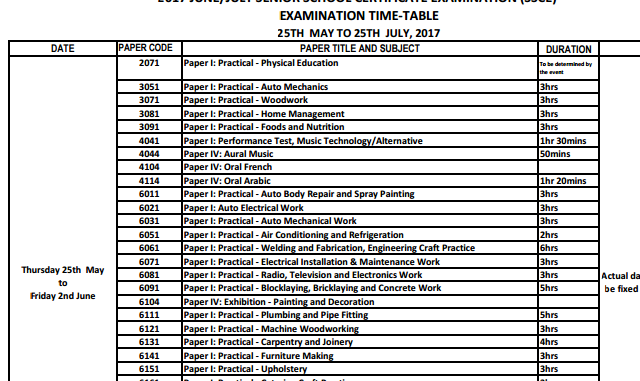
2018 NABTEB AGRIC SCIENCE QUESTIONS AND ANSWERS NOW AVAILABLE
Agric obj NABTEB 2018
1 – 10 ABADDABABB
11 – 20 BABCDDCAAD
21- 30 ABADDBBBAB
31-40 CCBBDDDAAC
41-50 AAABDCDAAA
2a.)
1. Land tenure system: The land tenure system in Nigeria to an extent discourage farmers from acquiring enough land for large scale farming. This is due to the fact that the land ownership act encourages fragmentation of farm land. This hinders agricultural mechanization. Because, it is only commercial agriculture that supports mechanization.
2. Poverty and Inaccessibility of credit:Majority of the Nigerian farmers are poor. So, they lack the fund needed to purchase sophisticated farming machines. The inaccessibility of commercial and federal government loans also worsens this problem.
3. Scarcity of machinery: Even the few farmers that can afford these sophisticated farming machines suffer setback. Because these equipment are not locally manufactured. And importing them from abroad attracts additional expenses. In the form of import duty.
4. Poor infrastructure: The poor state of infrastructural facilities in Nigeria is also a factor hindering agricultural mechanization. Mechanized agriculture encourages mass production for export and future supply. However, this aim is often defeated by the poor state of infrastructures in the country. For instance, poor road network, electricity and processing facilities leads to food waste
5. Illiteracy of the farmers: If estimate is anything to go by. we have it that about 60 percent of Nigerian farmers are illiterates. This makes it difficult for them to adopt modern farming techniques. Or operate the machine even when it is available.
6. Lack of maintenance technicians: Even when these sophisticated equipment are available, there are no technicians to take care of them. Or repair them when the need arises.
2bi) (PICK 5 ONLY)
1. It is mostly practiced by peasant farmers.
2. It involves a small area of land.
3. It involves the use of local tools eg hoe, cutlass etc.
4. There is no specialization.
5. It employs unskilled labour.
6. The harvest returns are small.
7. It usually involves the use of family labour.
8. It involves mainly the production of food crops alone.
9. It provides for the basic needs of the family.
10. There is little or no surplus for sale.
11. Mixed system of farming is usually practised.
Problems of Subsistence agriculture
2bii) (PICK 5 ONLY)
1. Sole cropping system is usually practiced
2. It involves the cultivation of large hectares of land
3. It involve huge investments of capital
4. It involves the use of hired labour
5. Most operations are mechanized
6. It employes skilled labour
7. Output is usually high
8. Improved varieties of crops and breeds of animals are used
9. Records are kept for proper accountability
4a) Egg candling is a necessary part of the incubation process, that helps you identify whether the embryo is developing as it should, or whether something may have gone wrong and you have to remove it. It’s really easy to do, and can save you lots of trouble later on by spotting a dud egg early. Egg candling should be done approximately three times during the incubation process. Doing it on day 4, day 10 and day 17 is plenty.
4bi) Poultry house sanitation plays a crucial role in the reduction of pathogens and biological load. Removal of old litter followed by Cleaning and disinfecting of facilities helps reduce pathogen numbers and break disease cycles. In addition, as live production becomes the target area of programs for the reduction of human pathogens such as Campylobacter and salmonellae on poultry carcasses, it will become necessary to document that sanitation procedures are effective. Unfortunately, poor sanitation procedures and/or increased soil m9isture levels have been linked to increased or sustained bacteria levels (Rudolfs, et. al.1950. Pepper et. al., lp93.).
4bii) Commercial poultry feeding is a highly perfected science that ensures a maximum intake of energy for growth and fat production. High-quality and well-balanced protein sources produce a maximum amount of muscle, organ, skin, and feather growth. The essential minerals produce bones and eggs, with about 3 to 4 percent of the live bird being composed of minerals and 10 percent of the egg. Calcium, phosphorus, sodium, chlorine, potassium, sulfur, manganese, iron, copper, cobalt, magnesium, and zinc are all required. Vitamins A, C, D, E, and K and all of the B vitamins are also required. Antibiotics are widely used to stimulate appetite, control harmful bacteria, and prevent disease. For chickens, modern rations produce about 0.5 kg (1 pound) of broiler on about 0.9 kg (2 pounds) of feed and a dozen eggs from 2 kg (4.5 pounds) of feed.
4c)
1. Berkshire
2. Mulefoot
3. Tamworth
4. Large Black
5. Hereford
6. Landrace
5a) LAND may be defined as the uppermost layer of the earth’s crust on which agricultural and non-agricultural activities are carried out.
5b)
1. AGRICULTURAL LAND (e.g 1. land for crop production. 2. livestock producton)
2. NON-AGRICULTURAL LAND (e.g 1. Mining. 2. industrial or factory use)

Leave a Reply